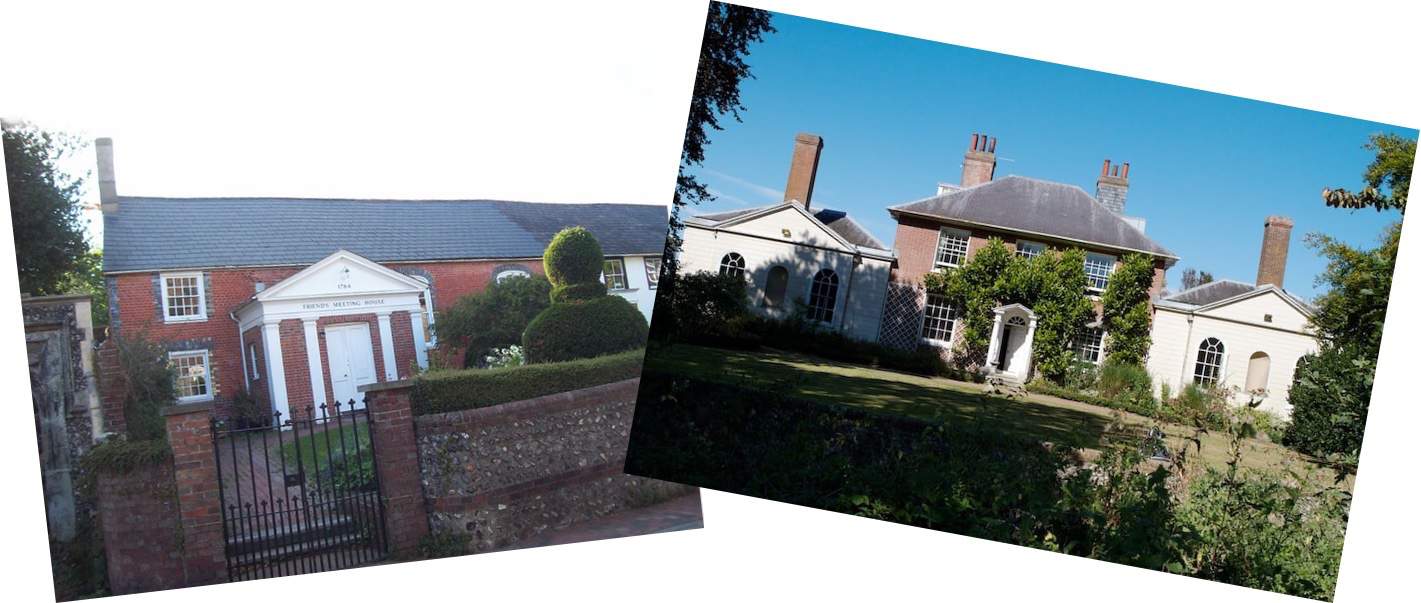Early Memories of a Southwick Quaker
A unique record of the 1830’s Southwick childhood reminiscences of Lucy Rickman Penney (nee Lucas). Documented by B. R. Bryant in 1913 it was discovered in Southwick resident Alf Browning’s collections and has been kindly loaned by Yvette Hammond and photographed by Neil De Ville.
The complete 42 page typed document includes the Lucas family’s travels to, and living at, various places far beyond our locality. Selected extracts have therefore been made together with additional background research to provide a little of the story of Lucy’s Quaker family during their residence at Southwick that include visits to the Brighton Meeting House and her father’s beautifully described walk to Portslade.
Whilst the memories are primarily those of Lucy the story is written by Bryant in the third party e.g., he sometimes refers to Lucy’s father and mother as ‘the father’ and ‘the mother’ instead of ‘my father’ and ‘my mother.’ Bryant however would either have been reading from Lucy’s original writings or listening to her relating the story (both Lucy and Bryant appear to have signed the 1913 document). Apart from one account by Edward Lucas certain pertinent extracts shown in italics have therefore been written as if they were Lucy’s own words which, of course, they originally were.
Roger Bateman
May 2021
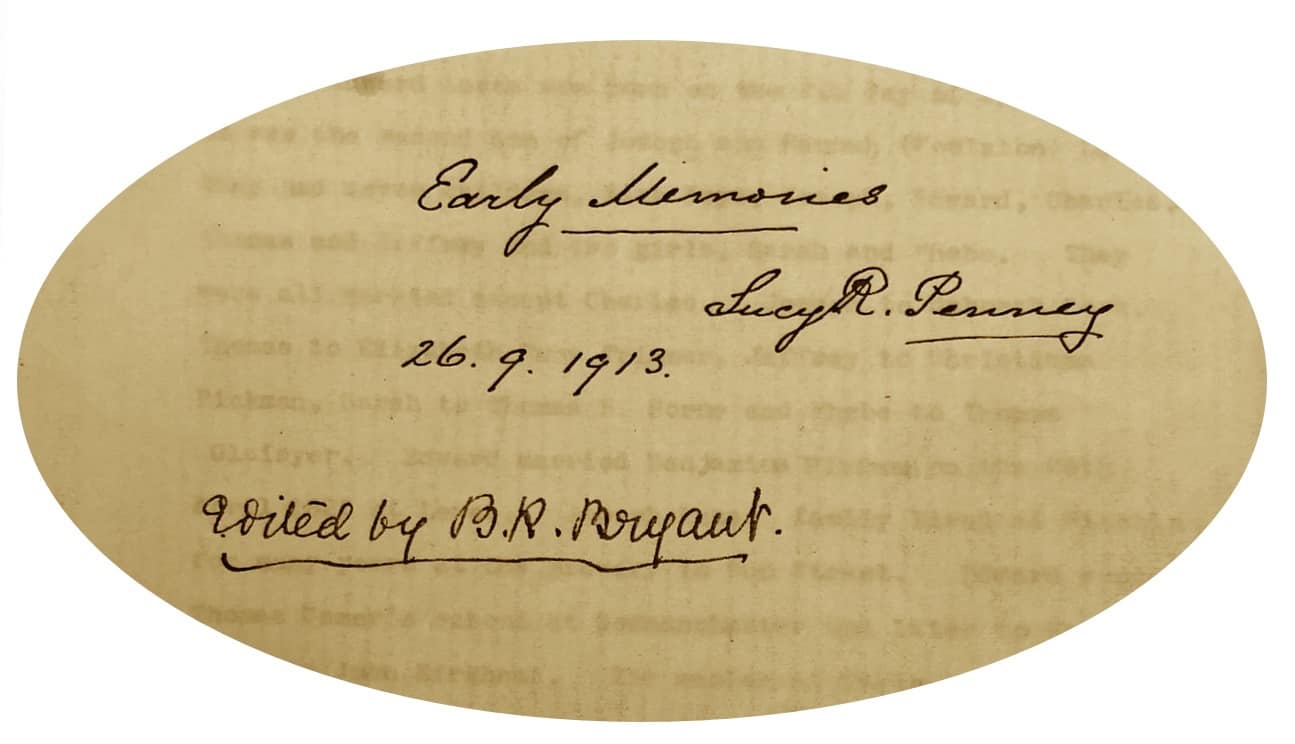
Edward Lucas was born in Hertfordshire in 1803. He was first apprenticed to his cousin Isaac Bass of Brighton then later joined Thomas Lidbetter, a corn and coal merchant of Southwick. He married Benjamina Rickman 25th April 1827 at Lewes and settled in Southwick with his bride after her father had bought the business for Edward.
At the time of their marriage Benjamina was twenty-five and Edward twenty-three. He had curly hair, blue eyes and an upright figure. She had straight brown hair, blue eyes and a beautiful complexion. They were married in the morning at the Friends Meeting House at Lewes.
Afterwards the couple with friends and relatives repaired to Benjamina’s parents’ home for dinner, Wellingham House near Ringmer, a substantial building that had its own laundry and bakery, garden grotto and summer house – in Lucy’s words ‘a palace of delight’ in keeping with a well to do family of that time.
Later that day Edward and Benjamina left in their gig for Southwick taking their bridesmaid Priscilla, Benjamina’s sister, with them. It was the usual thing in those days for a bridesmaid to go to the new home after the wedding on a long visit. One would think she might sometimes feel herself rather in the way!
The home at Southwick had been carefully got ready by cousin Sarah Woolston and the larder filled, and the bride found somewhat to her dismay among other things a large fillet of veal and a ham and wondered if they could ever eat them up.
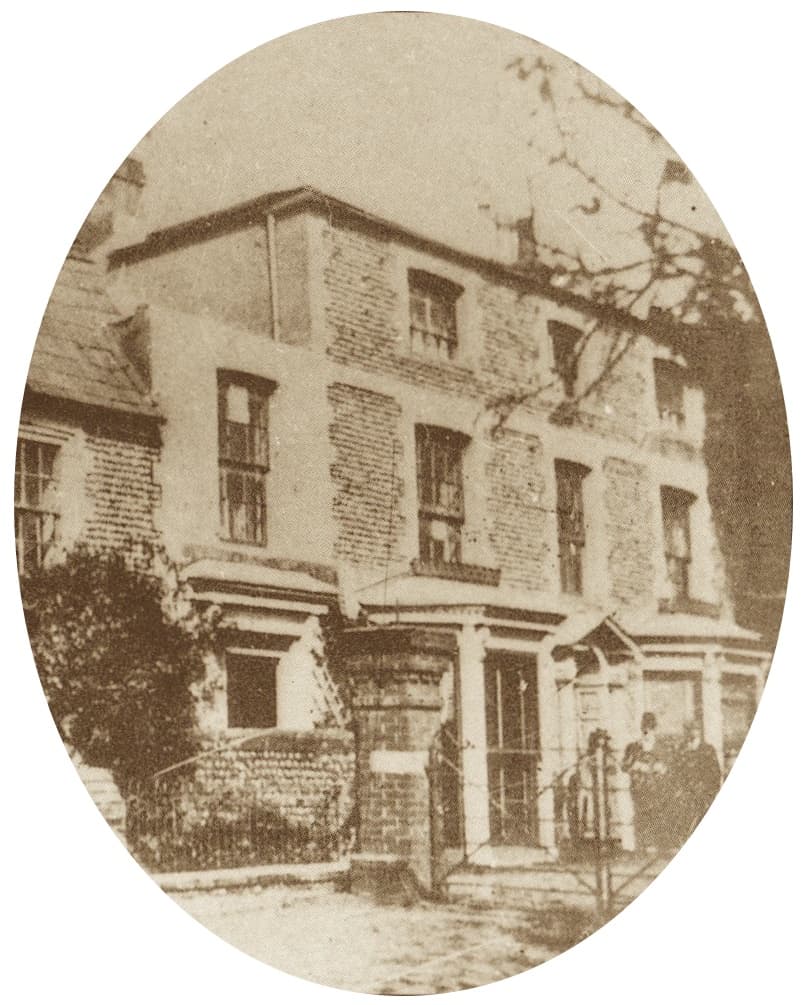
The Southwick home was called Alexandria House (Bryant particularly spells the name with an ‘i’ whereas other current day references to it do not. It was in a part of Southwick then known as Alexandria – the house was later to be renamed ‘The Grange.’) and was comfortable and commodious with an old fashioned boulder front which one seldom sees now, close to the harbour and at right angles to the high road. There was a carriage drive and a small lawn in front and several meadows belonged. Behind the house was a coal yard and from the top windows could be seen Beachy Head lighthouse with the revolving light.
The Children
In 1828 the eldest child Hannah was born. She was a clever and unusual little girl and sometimes almost frightened her mother by her precocious ways. When she was quite a baby she was put in a cupboard in the chintz room as a little punishment and the next time she was naughty said gaily “Better put her in the chintz room closet.” Another time she walked into the coal yard and deliberately sat herself down in a large black puddle of water.
The second child was Lucy Rickman, born May 14th 1830 and then Gulielma and Margaret came in quick succession. Margaret was born on her mother’s birthday (June 29th 1833) a charming birthday present for she was a dear, curly headed little girl with a most sweet disposition and a great favourite with her father who called her “Tick.”
John Edward was born on the 26th December 1835. The four little girls were having a special Saturday hair brushing in the nursery from their nurse, Eliza Bishop (who sometimes wore a red gown with yellow spots on it) when Aunt Anne came bustling in and said that a little brother had come for them. The sisters were delighted and decided at once that his name should be “Darling” Lucas.
The next children were twin boys and did not live then Alfred in 1841 and Bernard in 1844 but by this time the girls were away at school (boarding school in Lewes). When Lucy left school she began to teach Alfred. When he was eight it was decided to take him to Bayley Hall School in Hertford but the plan did not answer and he soon came home again looking much altered. After a time he returned to Hertford and did better.
Dear little Bernard, after having been very well during his first few years had a long time of invalid life resulting in a severe hip complaint and consequent lameness. He had a devoted nurse (Elizabeth Fry) through most of his life who spared no pains in carrying out the minutest of directions to give him relief. He had many changes of air from home and more than one operation. In time he became much better, even went to school in Tottenham and was later engaged in engineering work but some unwise exposure to damp seemed to cause a recurrence of the bad abscesses in his thigh and was never well again. He died in 1871 aged only 26.
The children’s Aunt Anne Horne from Arundel came to Southwick to help out temporarily with the children but was so indispensable that she ended up staying for over four years. It was a treat to go for a walk with Aunt Anne, she wore a large straw bonnet and black silk coat, and always low shoes with sandals for her feet were tender and could not bear pressure. On summer days she would take a little basket of cherries to be eaten in ‘the valley field’ close to Kingston Lane. It was probably in 1833 that Aunt Anne settled in a little cottage (in Albion Street) close to the family house and this was her home for many years. She wore very large caps stretched over a frame and curls which some people did not think grew on her head – anyway the little nieces thought them beautiful and she was always ready to supply a curl of her own hair if their dolls lost their locks.
Southwick was by the sea and had a pretty village green with the South Downs behind. The lanes were pleasant too, there were wild roses and honeysuckle on the Downs and thrift, horned poppies and bugloss grew on the beach.
Portslade Walk
Nearby Portslade was a charming village then and a favourite walk with the family. One evening their father with Hannah and Lucy had such a pleasant walk there that he wrote an account of it:- One evening accompanied by my daughters Hannah and Lucy, we set off for a walk to Portslade (taking a route that appears to approximate to the path up the length of the Green to its top, along Roman Crescent, on to Southwick Street then over the Old Shoreham Road and up Mile Oak Road towards Portslade village – in those days that was all in the countryside); we went up the path and over the Green, long before we reached the end saw children running to open the gate leading into the fields. On reaching it found five or six expectant faces, which beamed with pleasure as Hannah and Lucy distributed some coppers, which I had furnished them with for this purpose……….
On entering the field the wind blew rather cool from the hills, unchecked by hedges or anything of the kind. A filed of clover attracted the attention of our near-sighted botanist (his daughter Hannah was short-sighted) preferred taking my hand and conversing with me. In this way we proceeded up the hill towards Portslade interrupted occasionally by a joyful exclamation by Hannah when a flower was gathered, the possession of which, although very common as to kind and perhaps not particularly elegant or beautiful in appearance imparted such real pleasure to this thoroughly rural girl.
On our way up the hill a hare started up in a piece of grass disturbed by a shepherd and his two dogs. The latter pursued and my little companions were much delighted at really seeing the hare which however soon left the dogs far behind.
The next object which attracted our attention was a pretty lark which rose out of the grass and commenced its upward flight singing as it went; we stood still to watch it and kept our eyes on it until it was very high but it did not soar out of sight so that we were enabled to witness its descent also. Hannah’s defective sight prevented her enjoying it so fully but Lucy was delighted.
On reaching the top of the hill Hannah said “Oh Papa! Do look round at the beautiful prospect. Oh the sun, the sun” and in truth the scene did appear as lovely as I ever beheld it, the eastern extremity bounded by the splendid mansions of the town of Brighton about 4 miles distant; the gently sloping fields covered with the fresh verdure of spring occupied the space for about a mile before us, then came the wide expanse of the British Channel gently ruffled by the northern breeze, and bearing on its bosom many vessels, some waiting off the Harbour in order to enter with the approaching tide, others passing by in full sail, whose white canvas gave a pleasing variety to the scene.
The spire of Southwick church embosomed in trees and the tower of that at Shoreham surrounded by houses added to the effect, and the plantation in the paddock at Buckingham to the west softened by the flowing and graceful outline of the South Downs stretching behind finished this prospect – the whole much heightened by the splendour of the setting sun.
Portslade (and may I not say in view of some little girls I know) delightful Portslade (obviously his children did not share the same opinion) inferior only to Bramber Castle, now lay before us and on passing by the pretty seat of John Hall we all admired the beautiful foliage of the sycamore so fresh and young and elegantly delicate and ornamented in some instances by a profusion of pendant blossoms.
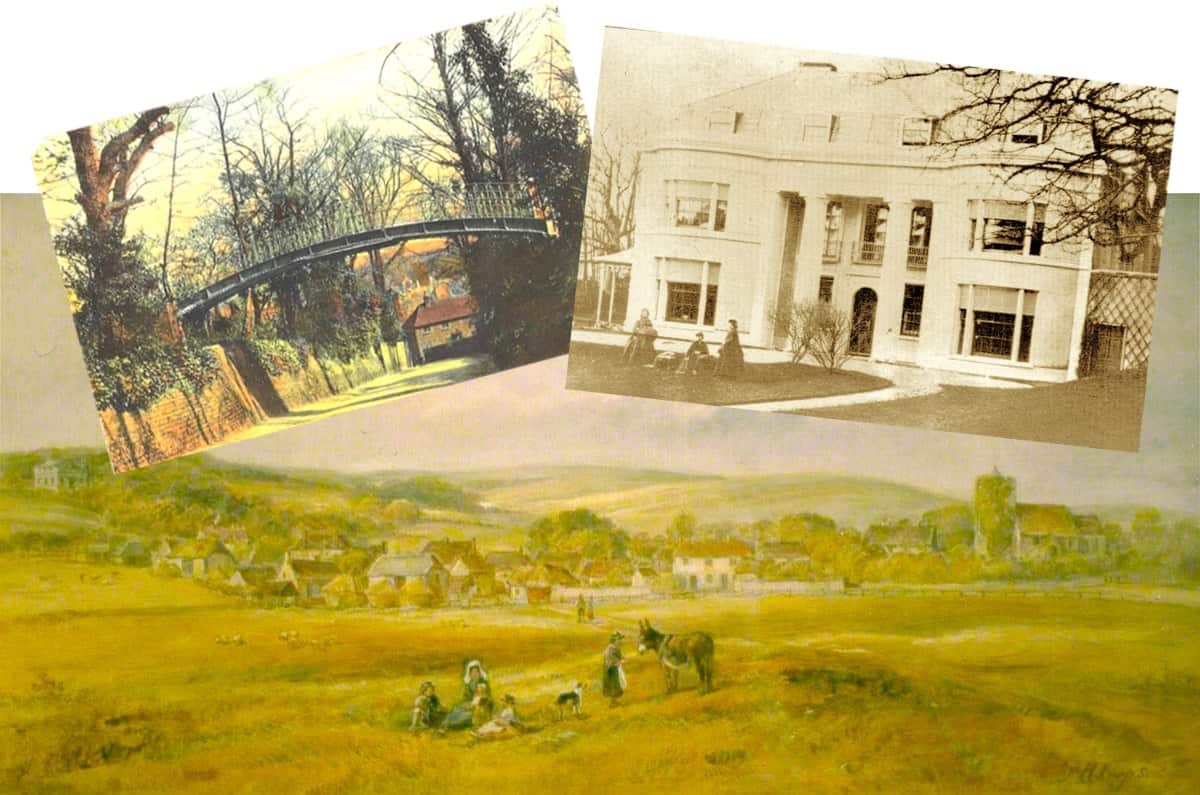
The magic bridge was enjoyed as usual, the call at Jane Geer’s cottage being made and the message being delivered Jane Geere (29 year old Jane Geere, her husband Charles and their two children are shown in the village during the 1841 census) we proceeded up the hill at the back of the village and Hannah guessed my intention for she exclaimed “Oh Papa do let us go to the cowslip field.” The said field was soon gained but our disappointment was great at finding it occupied by a flock of sheep who, liking cowslips as much as little girls do, had taken the liberty of eating them all up!
Being now on high ground we again halted and looked about us. The sun had just set behind the hills and the sober appearance of evening was beginning to shed its calming influence around; all was quiet and serene, the little village of Portslade ensconced between two hills exposed its almost every house to our view…………..the sounds of the evening too were also peculiarly evening’s own, the full song of the blackbird mingled with the monotonous but heart cheering notes of the cuckoo but the queen of the grove, the nightingale, was the most attractive and many times did we pause to listen to her melodies……. as twilight began to render objects less and less distinct there was one which improved every moment from the same cause and, during the remaining portion of our walk, shone forth in the firmament with her wonted silvery sweetness, an ever present memento to us below of one of the most beautiful as well as the most wonderful of the Creator’s works.
Education
Life at Southwick was punctuated by extended visits to relatives for periods of some months on each occasion. In November of 1836 when the children returned to Southwick after a four-month stay in Hertforshire they found a governess waiting for them – Lucy Hutchinson. She was a girl of eighteen and very pretty and lively and wore a ‘kamizoo’ a sort of fichu (a large, square kerchief worn to fill in the low neckline of a bodice). The first time she went to a Brighton Meeting an old friend, James Carter, said to mother “What a pretty creature she is” The little girls adored her and perhaps made more fuss of her than her mother. Lucy had a rose tree and now all the roses she could find were given to the governess until one day the mother said sadly ‘I don’t often get roses given to me now” which filled little Lucy with compunction.
The laundry was made into a schoolroom and a big bookcase bought for books and the four little girls established there with the governess. Their mother had taught them before and was a beautiful teacher making clever little rhymes to help the memory and having interesting ways of telling things. The governess was devoted to John Edward who was a most engaging little boy. Edward Lucas took great interest in his children’s lessons with Lucy Hutchinson and used to examine them sometimes, carefully writing a kindly but honest report afterwards.
Before long Lucy Hutchinson left them and married soon after. A girls’ (Quaker) boarding school was established at Lewes and in August of 1840 Hannah and Lucy Lucas were sent there. A new governess was taken on to take charge of Gulielma, Margaret and John Edward but was a poor substitute for the charming Lucy.
Edward’s Work
Edward Lucas used to attend markets, sometimes one every day in the week. Shoreham, Steyning, Worthing, Brighton, Horsham and Cuckfield. His cousin, Burwood Godlee used also to attend Steyning market and drove over from Lewes to Southwick, putting up and dining there going on with Edward most amicably though on arrival they would be competitors. Cousin Burwood would cut swans out of apples for the children. On Steyning market day it was a great delight to the children to go too and be put down at Bramber to get ready a picnic tea for their father on his return. They picked up sticks for a fire and when all was ready eagerly watched the footpath across the field for the first sight of him. They always walked around the castle moat and picked wild flowers to take home. When the market was at Worthing they sometimes went there and spent the time on the beach. In the summer they would be rowed across the harbour and take tea to the beach by the open sea. Aunt Anne was always nervous in a boat and used to say “Whoever moves shall have no jam bread for tea” which kept them all quite still.
They (the family) kept their own cows, pigs and poultry and had two horses, Blacky and Silver and a gig, a sociable (a four wheeled open carriage with double seats facing each other). and a four wheeled chaise. (The horses and carriages were used by the family to travel to places such as Hitchin, Luton and Northampton to stay with relatives – an indication of just how much, albeit in two stages, was expected of horses in those times.) The sociable was used for driving to meeting (the latter recorded by Bryant in the singular which was/is the way Quakers’ refer to their meetings) and was rather like a bathing machine. It was a present from the Wellingham grandfather. At one time it had a sort of chair fixed on for the driver but afterwards a seat long enough for one child to sit on each side Edward who drove was put on. He liked his children to read to him while driving along the rather dull road to Brighton.
The Southwick family used to drive to meeting at Brighton in the morning and again in the evening in summer and afternoon in the winter. Grover Kemp, Daniel Pryor Hack, Uncle Glaisyer, James Carter, Aunt Glaisyer, Sarah Bass and Eliza Hack sat facing the meeting then (perhaps where the elders sat).
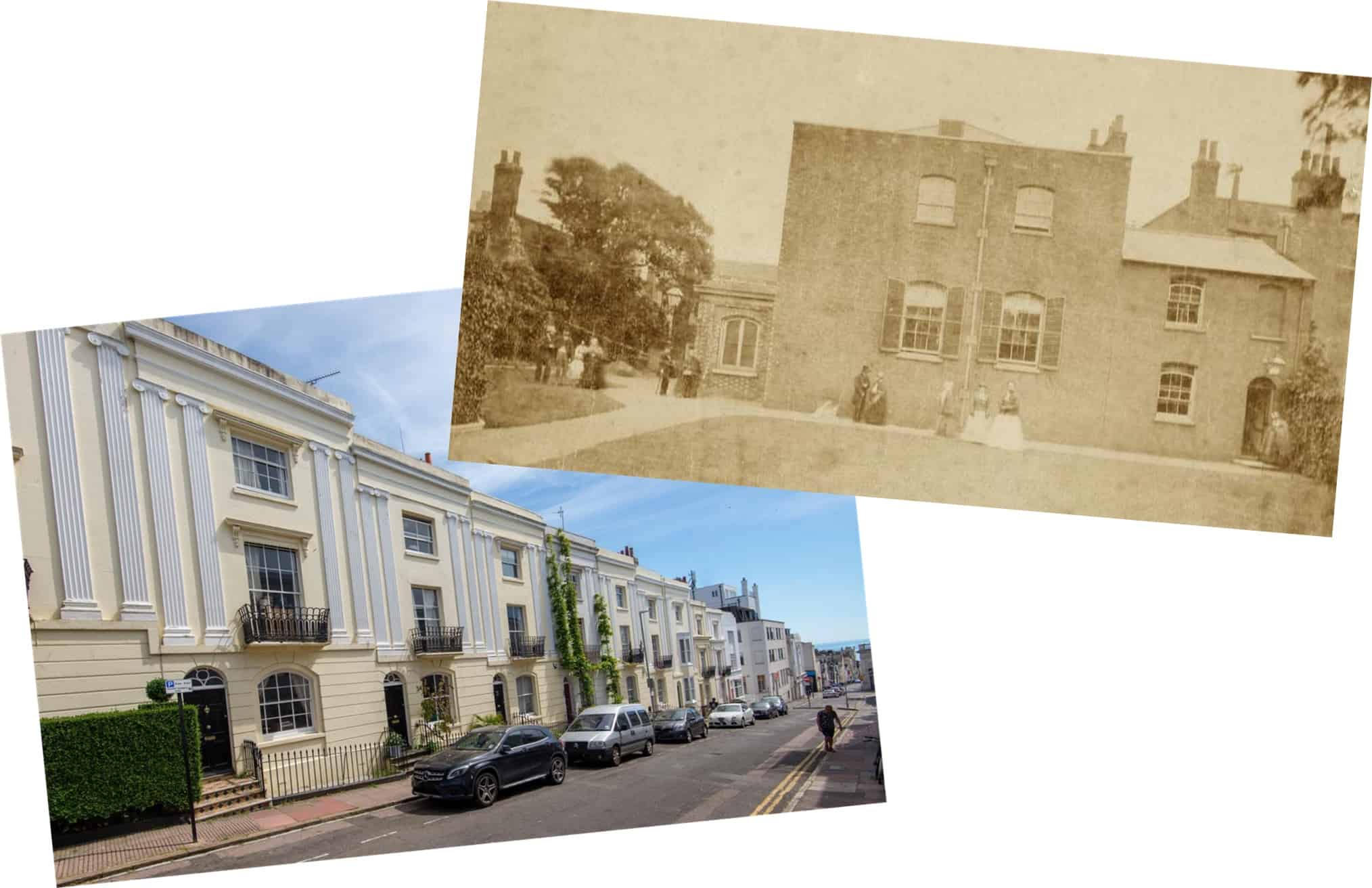
Edward had a coal office in Hampton Place where the carriage was left and they all walked to meeting (in Ship Street) about ten minutes away. For many years a man named James Clark had the charge of the Hampton Place office and after him William Morphy. All one winter Lucy and Hannah took turns to dine at Daniel Hack’s house on Sundays. In the winter sometimes the time was so short between coming home from morning meeting (especially on preparative or business meeting days) and going back in the afternoon that the family once dined in its outdoor clothes and started again immediately. On Sunday evenings till the children were quite grown up they used to sit around and say verses and hymns. Their father liked Hankinson’s and Whittier’s poems and Hannah was particularly good at repeating poetry.
Edward Lucas was a most delightful man. He always played with the children after tea before going back to the counting house that opened on to the dining room – dominoes or spillikins or card with questions and answers showing pictures to the smaller ones or joining puzzles. He often read aloud at teatime, ‘Evenings at Home”, “Winter Evenings”, “Franconia Stories” or other books by Jacob Abbot.
When Lucy was seven there was a great celebration for the Princess Victoria’s eighteenth birthday. The children were to have gone to Brighton to a public ceremony but finding it would be very crowded and not suitable their father gave each disappointed little girl a present instead.
It was quite a frequent sight to see King William the fourth and Queen Adelaide driving along the road through Southwick when they were staying at the Pavilion in Brighton. One day when driving near Buckingham (House) the family met the King and had to get nearly into the ditch to allow him room to pass.
Hannah’s birthday was the same as Sarah Bass, the daughter of Isaac and Sarah Bass, and the Southwick children sometimes spent the day in Brighton. Sarah had a beautiful doll’s house, which was a great pleasure to the visitors, and they were allowed to choose from a basket of little books.
When the railway came to Southwick massive quantities of earth and chalk excavated from the London Road cutting in Brighton were transported to build up the embankment at Southwick. An exciting undertaking for the children to witness but it did nothing to enhance the charm of the area, particularly not Alexandria House. The railway from Brighton to Shoreham was opened in 1840. The Southwick house was very much spoilt by it as the line went through the meadows on a high embankment. From the schoolroom window the children could see the carts as they came into view beyond the cart shed, tippimg up and emptying earth to make the embankment. When the line opened and the first time the family came home from weekday meeting by train it was a most exciting event. The (progress of the) line crept along to Portsmouth by slow degrees but the London to Brighton line was opened in 1841.
In order to more effectively operate his corn and coal business Edward had built up a small fleet of modestly valued ships; Adur a 36 ton schooner built and purchased in 1832, Fearon a brig of 155 tons in 1830, Spry a schooner 1847 149 tons, Amulet a 208 ton snow purchased in 1840; a steamship SS Princess Royal in 1841 Ruby, a brigantine built 1805 at Aberdeen and purchased by Lucas in 1844, Trial and Menodora, Canadian-built brigantines in 1850; the Kingston a schooner built in 1838 by local firm May & Thwaites and the Sunderland-built collier Jessamine in 1840.
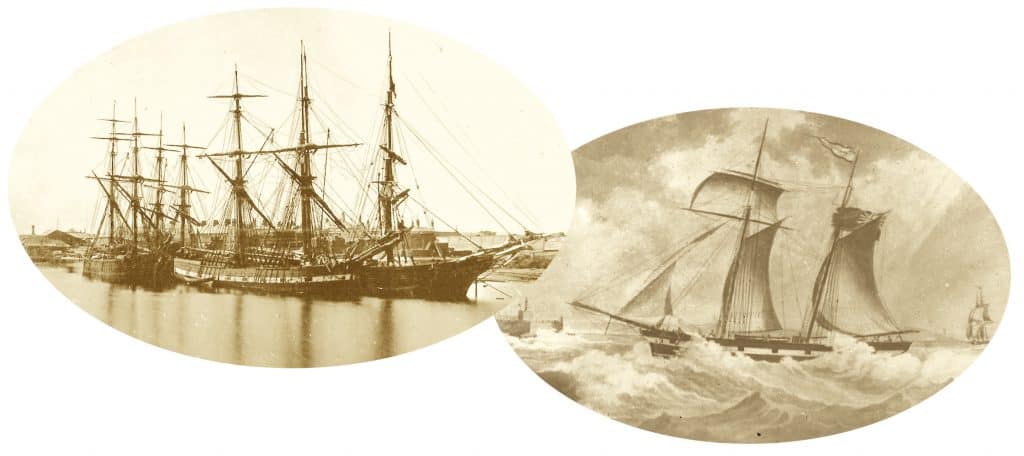
During the early 1850’s Robert Horne Penney from Poole, a second cousin to the family joined the Lucas family business at Southwick. Two years later Edward decided to enter into partnership at a bank in Luton (ultimately merged with others to become Barclays Bank, itself a Quaker business in origin) and Robert took over the Southwick business. Edward eventually retired to Brighton where he died at Buckingham Road on 28 November 1874.
In the meantime Robert Penney had obviously taken to Lucy Lucas during his early years in Southwick and, despite the distance involved, maintained the relationship and married her in Luton in 1853. They moved in to Alexandria House and went on to have seven children of their own but sadly only three were to survive. Since taking it over Penney developed the shipping side of the business considerably but of course that story has already been well documented. In 1871 Robert and Lucy moved their home and office to Brighton thereby ending the Penney and Lucas family’s 40-year residence of Southwick.
Lucy Rickman Penney (nee Lucas) born 1830 died 1919
Sources:-
- ‘Early Memories’ by Lucy R. Penney, edited by B.R. Bryant 1913
- ‘Quaker Ship owning in the Port of Shoreham c.1824-1880’ by Kenneth Wilcox
- ‘Hove in the Past – Robert Horne Penney’ by Judy Middleton


